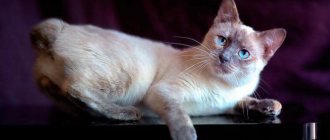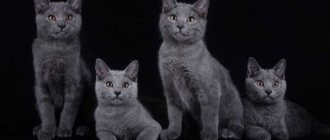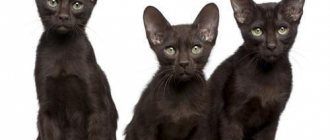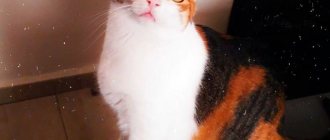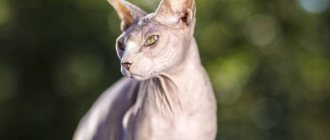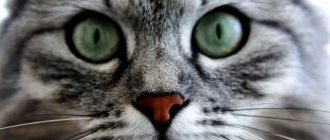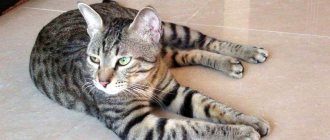Origin story
The starting point in the development of the breed is considered to be 2005: it was then that the Osborne couple from Arkansas acquired an unusual-looking kitten: tiny, with short legs and a complete absence of hair on the body.
The baby was named Bambino for his sweet appearance. Time passed, the kitten grew, but remained the same miniature and short-legged. The couple realized that the matter was clearly a genetic mutation, and decided to try to establish a new breed.
Experimentally, it was possible to find out that the parents of the first bambino were munchkins and Canadian sphinxes. The work began to boil and already in 2005 the first “samples” began to appear at exhibitions. The breed received experimental status and geneticists were involved in the matter.
Many people condemn such crossing: it is believed that interspecific breeding is unsafe for the offspring, causing external deformities and genetic abnormalities. However, the bambino had so many fans that the social activists were unable to stop the work. They started breeding these cats in Russia, and at the same time. But, since they had no family ties with the Osborne pets, the breed line received its own special set of genes.
A bambino cat is expensive: a pet cat will cost about 90-100 thousand rubles, a breeding cat will cost over 200 thousand rubles. An elite cat will cost a cosmic sum. Also take into account upcoming expenses on food, cat cosmetics, etc.
Feeding ration
Feeding such cats is not the easiest issue, since the structural features of the gastrointestinal tract do not allow it to get enough immediately, even with a good appetite. Owners should not worry if the cat, briskly running up to the plate, has a small snack and moves away. A little later, she will definitely return and continue her meal, eating the contents of her bowl in several approaches.
Bambino, like Sphynx cats, has an accelerated metabolism, so its representatives eat slightly more food than ordinary cats. Given the youth of the breed, these cats can eat anything - both natural and industrial food. They adapt well to all types of food.
Thus, the owner can determine for himself how, when and what to feed his pets. And if you observe your cat’s preferences, you can give her pleasure by changing her diet using her favorite dishes or products.
Standards
Bambino cats are elegant and graceful creatures, although not without features that are unusual for the human eye. Outwardly, they resemble dachshunds: they are just as long, strong, with a rounded back and a belly as round as a ball. They weigh little: 2.5-4.5 kg. Females are visually smaller than males.
| Standard | Description |
| Head | Wedge-shaped, with a straight nose (the stop is barely visible) and prominent cheekbones (the pinch underneath is clearly visible). The whisker pads are dense, plump, the whiskers are broken, and the chin is clearly defined. The ears are large, wide at the base and rounded at the tips. The inside of the auricle is smooth, hairless, and covered with flock on the outside. |
| Eyes | They are shaped like a lemon, placed at a distance from each other and noticeably squinted. The iris can be anything, but a mandatory requirement is to match the color of the coat. |
| Torso | Elongated, with strong bones and a broad chest, chiseled shoulders and a massive neck. |
| Limbs | Short but strong, the front ones are visually longer than the front ones. The toes are long, graceful and very flexible. The pads are elastic and plump. The tail is of medium length with a tassel at the tip. |
| Wool | It may or may not be present (gummi type). The body feels like velor to the touch. |
The bambino's skin is very thick and wrinkled. The neck, muzzle, shoulder area and between the ears have the most folds.
Content
There are several features in keeping a bambino that it is important for future owners to know about. The room temperature should be comfortable, within 22-25°C, it is advisable to avoid drafts.
If it is not possible to maintain the necessary microclimate, you need to take care of additional insulation for your pet and choose comfortable clothes. In the cold season, it is necessary to ensure that the delicate skin is not damaged by the hot radiator, and in the summer, protect the baby from ultraviolet rays. Lounging in the sun or on a windowsill on a clear day, a cat can not only get sunburned, but also get a serious burn. Otherwise, the requirements are the same as for any other cats. The pet should have personal bowls for water and food, a tray with suitable filling, a scratching post, or better yet, a play set, a couple of toys, a bed or a cozy house in which the child can retire and relax.
Diet
It is necessary to determine in advance what type of feeding will be: natural or ready-made food (dry, wet). The diet and diet depend on age, but it is advisable to follow a regimen to which the pet will quickly get used to.
Bambinos have adopted a good appetite from sphinxes, so it is important to focus not only on the cat’s desire, but also on the recommended portions in order to prevent obesity and related problems.
Character and behavior
The character of the Bambino matches its name: cats of this breed are infinitely kind and devoted to their owners. They have no desire to hunt at all, therefore, no matter who lives in your house - a chattering parrot, a panting hedgehog, a restless hamster, another cat or dog - the bambino will quickly find a common language with him. Do not let your cat walk alone: he is in danger in the form of unfriendly animals. Bambino will not be able to repel an opponent even of his own size, so do not let your pet out of sight.
A smart and quick-witted bambino quickly learns all the rules of the house in which he lives. He runs to his litter box not only when he needs to, but also when he feels sick, so buy a container with low sides so that it is convenient for him to climb into it.
They love people and company, feel extremely uncomfortable alone and begin to break into closed doors with all their might. These are eternal children: they need constant attention, affection, lots of toys and control. Curious cats can jump from a height, stick their nose into a hot oven, try an electric wire on their teeth - in general, they have plenty of worries. Sometimes their attention is attracted by things that other cats are not interested in, so hide small and dangerous things away.
Rules for choosing and price of a kitten
Considering the youth of the breed, a high-quality kitten that meets the standard can only be purchased in a specialized nursery. Private breeders simply failed to breed a normal litter, so there is a high probability of purchasing an ordinary Canadian Sphynx instead of a bambino, which may not even meet the standards of its breed.
Purchasing an “official” kitten guarantees that the baby will be the exact breed you purchased. In the nursery you will be able to get a pedigree, recommendations on caring for a new family member and his nutrition. In addition, in most cases, you can also see the baby’s parents to evaluate its thoroughbred in accordance with the requirements of the TICA association.
The kitten must be vaccinated, kept in proper conditions and trusted by people. Before purchasing, you need to pay attention to the following visually assessed factors:
- transparency and “smartness” of the eyes;
- clean ears;
- absence of unpleasant odor from the animal;
- lack of fear towards strangers;
- straight tail.
Important! Female kittens are valued slightly higher than male kittens.
Due to the rarity of this type of cat, the price of a bambino is steep. Prices vary significantly by class:
- Pet - the purity of kittens of this type is violated by breeding marriage, which makes breeding such an individual undesirable. Often, defects in breeding may not be noticeable to the uninitiated, but breeders accurately identify and reject such babies. Because of this, their cost is lower than their higher-quality counterparts - usually this amount ranges from 800 to 2500 thousand US dollars.
- Breed is a higher class, where any defects and injuries are excluded. This includes animals that range from normal conformation to extreme appearance. The quality level of the class is considered to be sires that are capable of producing offspring without clear characteristics - average standard bambinos. Such cats are calm when mating, quiet when bearing, and caring when caring for and feeding their offspring. At the same time, they give birth to many healthy and high-quality kittens. The price for such babies is from $2500 to $3500.
- Show assumes an ideal animal in all respects of the species. Such a representative of the breed should be pleasant to look at without any irritation, he should have ideal characteristics of the breed, a pronounced extremity of the type and a calm disposition - this is required to participate in numerous exhibitions awaiting a cat with such a “star” appearance. These breed ideals cost up to $4,000.
Care instructions
Bathing
These babies should be bathed regularly 2-3 times a week, or even more often (depending on the intensity of sebum secretion). When it accumulates on the skin, it causes an unpleasant odor, so when you bring home a new resident, immediately buy a special shampoo for cats. If your pet has a cold and cannot be bathed, use wet wipes (without alcohol or fragrance) to clean it.
To make the animal comfortable during the procedure, lay a thick diaper in the bath or place a rubberized mat. Then the cat will not slide its paws along the bottom. The water temperature is no higher and no lower than +23-25 degrees.
Ears
The ears are cleaned once a week using a cotton swab and chlorhexidine. Eyes - daily in the same way. Teeth – 2 times a month using cat toothpaste and a brush (you can also buy a children’s brush).
Claws
If a cat sharpens its claws on its own, it will not need your help. Otherwise, trim the claws once a week with a nail clipper, being careful not to damage the blood vessels or scratch the skin on the paw.
Do you trim your pet's nails?
Yes, he’s lazy with us. No, he sharpens himself.
Walks and bling for games
When walking a representative of this breed on the street, it is necessary to wear a collar and a leash, since, given its diminutiveness and timidity, the owner runs the risk of looking for his pet in dense thickets of plants or under any structures.
Bambino shows his childish character all his life, so he finds toys in any objects - from specialized cat toys and play sets to any object that comes into his field of vision, whether it is moving or not.
Such a cat is happy to take walks and relaxation of its owners in nature, where it was kindly invited, and tries to be the life of the party. She enjoys walks, the arrival of guests, and trips somewhere. In other words, the animal seeks pleasure in almost everything positive that surrounds it. At the same time, the bambino does not see any cat toy, other object or pet as an enemy or an object of hunting - aggression and hunting instincts are completely absent in this peace-loving breed.
Catering
Accelerated metabolism is another feature of bambino cats, but this also poses a danger, namely gluttony, which can lead to obesity and related problems. Therefore, do not react to your cat’s plaintive meowing and paw slap on an empty bowl: feed her exactly as much as required by her weight, and do not indulge her with snacks between main meals.
Keep bowls clean. They need to be washed after every meal and the water changed 2 times a day in the mornings and evenings.
Kittens up to 4 months eat 6 times a day, over six months - 3-4 times, over a year - at least 3 times.
At first, feed the baby the same thing that the breeder fed him, and introduce new food gradually. Whether you switch it to natural food from industrial food or vice versa - it doesn’t matter, the main thing is that the products must be of high quality, without chemical additives. What is suitable for humans is not suitable for animals, so remember a few nutritional rules.
Natural products
Bambino cats, like other cats, should not be fed from your table. Human food - fried potatoes, rolls, fatty soups, etc. - causes serious health problems in animals. But they don’t taste sweets at all, they can eat it with great appetite and become seriously poisoned in the future.
The basis of natural nutrition is lean meat, dairy products, cereals, vegetables and eggs. Meat (beef, veal, rabbit, turkey, lamb) should first be kept in the freezer for a couple of days, and scalded with boiling water or boiled before serving.
It is mixed with porridge cooked in water (oatmeal, rice, corn, buckwheat, millet or semolina), adding some vegetables (zucchini, pumpkin, carrots, beets, beans), fresh herbs (parsley, dill, green salad) and a spoon of any vegetable oil (sunflower, olive, flaxseed).
3-4 times a week the cat should be given dairy products: hard unsalted cheese, cottage cheese, yogurt, fermented baked milk, natural yogurt. From time to time, meat can be replaced with offal, stewed chicken hearts, liver, gizzards, ground into minced meat. The eggs are boiled and only the yolk is given from chicken eggs, whole quail eggs.
The following products should not be given:
- Salted (including pure salt), smoked, pickled, fatty;
- Condiments, sauces, spices, seasonings, aromatic herbs;
- Offal, lard, bones (including boiled chicken, especially dangerous);
- Potatoes, tomatoes, eggplants, fruits (exception: apples, pears, melons and watermelons);
- Human drinks;
- Dog food.
Recommended food
Economy class cat food: Wellkiss, TerraCot, 365 days.
Premium: Zoogurman, Mnyams, Native food.
Super premium: Pronature Life, Summit, Vet Life.
Holistic: Orijen, Power of Nature, Wildcat.
Below are recommended super-premium foods. Links with the names of the food are clickable, on them you can, within our website, read the descriptions of the food and read reviews from owners of Bambino cats.
| Premium | Super premium | Economy |
| Sirius | Leonardo | Perfect Fit |
The vitamin and mineral complex is selected taking into account the individual needs and parameters of the animal (age, weight, activity, concomitant diseases, etc.). Popular: “Agrovetzaschita”, “Farmaks”, “8 in 1”, “BEAPHAR”, “Doctor ZOO” can be bought at any veterinary pharmacy. In addition to vitamins, the cat should be given dry brewer's yeast in courses, according to the instructions.
Table: pros and cons of the bambino breed
| Advantages | Flaws |
|
|
Diseases
Bambinos are not long-livers: today, since the breed is still very young, the upper limit does not exceed 12 years. But everything can change: breeders are confident that if the breed is rid of hereditary problems, individuals will be able to live several years longer.
We managed to overcome the first problem, or rather, learn to cope with it with minimal losses. We are talking about hypertrophic cardiomyopathy - a pathology of the heart muscle that leads to the sudden death of a pet at a very young age. Most often, the disease occurs in males.
The animal becomes lethargic, refuses to play and does not want to run, it develops shortness of breath and coughing, fainting, and paralysis of the limbs. This pathology was inherited from the Canadian Sphynx and, unfortunately, it is impossible to cure it. But improving the quality of life with the help of drug therapy and regular medical supervision is quite possible.
The second problem also causes bambino owners a lot of trouble: weak immunity. Breeders especially recommend that owners not allow pets to come into contact with street animals, and also carefully plan the menu and ensure that the animal does not become hypothermic.
Expert opinion
Dusheba Vera Ivanovna
In 2010, she graduated from the Moscow State Academy of Veterinary Medicine named after K.I. Scriabin with honors, specializing in veterinary medicine. I regularly attend veterinary conferences, congresses, and webinars.
Many felinologists believe that the use of immunomodulators is not justified: they are expensive and do not have the desired effect. In any case, only a doctor should prescribe them.
Naturally, you should not refuse preventive vaccinations: against rabies, panleukopenia, calcivirosis, and the like. These diseases can lead to the death of your pet, and you can easily introduce pathogens into your home on your hands or the soles of your shoes. Please remember that you cannot:
- Use low-quality vaccines or expired vaccines;
- Vaccinate cats weakened after illness, exhausted, wormed (with the exception of extreme necessity), pregnant and lactating females, and babies;
- Individuals who have been in contact with suspicious and sick animals.
Vaccination against shingles is not mandatory, but is advisable if your cat lives in the same room as a dog.
Female bambinos successfully give birth and raise their offspring. Cats reach sexual maturity at 7-8 months, but it is better to introduce them to a cat within a year and a half. Usually no more than 4 kittens are born in a litter (every 4th embryo does not survive when mating such miniature individuals). If you do not plan to breed, have your cat spayed. “Empty” heats often lead to the formation of tumors.
Breeding
Bambinos, like representatives of any other breeds, need to be spayed at the age of 8 - 12 months. Kittens are often sterilized by the breeder to prevent the possibility of breeding by a new owner.
Bambinos are very difficult to breed. It is not advisable for those who do not have such experience to do this. When mating two dwarf individuals, approximately 25% of the embryos are not viable. Therefore, a cat most often has no more than 3 - 4 kittens in a litter.
Some kittens in the litter are born with normal long limbs. They are subsequently crossed with dwarf individuals to obtain healthy offspring. Bambino cannot be bred with other breeds.
The female's first estrus occurs at the age of 7 - 8 months. But in order to have a higher chance of getting healthy offspring, animals must be bred at the age of 1.5 years. It is advisable to choose an experienced male. If he does not have experience in covering a cat, conception may not occur due to stress. You also need to make sure that the cat is healthy and does not have genetic diseases.
It is important to prepare partners for this process. A month before mating, animals need to be dewormed and vaccinated two weeks later. Immediately before the procedure, their claws should be trimmed so that they do not injure each other (which often happens during mating games). Animals should not be washed to preserve their natural scent.
Most often, the female is brought into the male's territory. This is due to the fact that in a foreign place he may feel insecure, and there may be no coverage at all. For the cat, you should bring its bed, bowls and a tray, because the animals will need to be left alone for 2 - 4 days. This measure will help her relax and feel calmer; over time, she will begin to trust her partner and let her come to her.
If the mating is successful, pregnancy occurs, which lasts 62 - 65 days. The first signs appear 2 - 3 weeks after fertilization. The cat's nipples enlarge and become brighter, and soon the belly begins to grow. You should prepare a quiet, secluded place for her to give birth in advance, for example, take a box, make an entrance in it and lay a soft and clean cloth. The cat should be comfortable and comfortable in this house.
During pregnancy, it is important to provide your cat with rest and good nutrition. She should not be allowed to run and jump too much, she should lie down and rest more often, it is necessary to exclude stressful situations
A few days before giving birth, the expectant mother's behavior will change: she will become restless, lick herself more often and generally behave unusually. She can suddenly get up and lie down again, move her paws through the bedding, and prepare a “nest” for the birth of babies. When contractions occur, the cat lies down and stretches out its hind limbs, its nose and ears become cold, its temperature drops, and it breathes quickly. The first baby will be born in an average of half an hour, if everything goes well. The rest will follow. Childbirth can last from several hours to a day.
A newborn kitten weighs on average 80 - 120 grams
During the first pregnancy, it is advisable that the birth take place in the presence of a specialist or veterinarian, as the cat may require urgent care. If the owner decides to independently control the process, you need to be nearby and, if necessary, provide assistance to the pet.
Health and susceptibility to disease
The average lifespan of a bambino is 12-14 years. Relationship with sphinxes and munchkins affected not only the appearance, but also the health of these hairless cats with short legs.
From the former they inherited a predisposition to hypertrophic cardiomyopathy, from the latter - a tendency to lordosis. In addition, representatives of the breed are susceptible to sunburn, dermatitis and colds.
Education and physical activity
Despite their mischievous nature, bambinos are easy to train. Cats with short legs easily get used to the feeding schedule and quickly master the skills of using a tray and scratching post. In addition to the basic rules of behavior, representatives of the breed are able to remember about 10 commands like “Come to me!” or “Bring it!”
Nimble and active, bambinos have anatomical features that limit their jumping ability. Therefore, they do not need high sports complexes. And so that cats with short legs have something to do, they buy a lot of toys for them.
Description
The distinctive features of bambino cats are their elongated body and short legs, which gives them a resemblance to a dachshund. The body is powerful, the muscles are well developed, the width of the chest and croup is the same. The legs are short, muscular, the hand and claws are very well defined.
The long thin tail is very mobile, tapering towards the tip. The skin is covered with folds. Newly born kittens are completely covered in folds, which are partially smoothed out by the age of one or two years. Completely smooth skin, as well as excessively folded skin, is considered unacceptable for the standard of this breed. The head is wedge-shaped, with a wide, folded forehead, high cheekbones, tucked “cheeks” and a slightly protruding chin. The ears are huge and erect. The large eyes have a slightly elongated shape towards the ears and come in different colors: blue, gray, yellow or green. Often there are options when one eye is yellow and the other is green or blue. These animals are small, the weight of males rarely reaches 4 kilograms, females are slightly smaller. The bambino's body temperature is about 39 degrees. In a litter of bambino cats, in addition to short-legged ones, there are kittens whose limbs are of normal length. They are also considered purebred, but are used only for breeding; they are not allowed to participate in exhibitions.
Bambino cat health
The bambino breed was bred quite recently - in 2005, so there is no data on their life expectancy. Felinologists say that on average they will live 13–15 years, but with good care they can live up to 18–20 years.
Bambinos, unfortunately, do not have a strong enough immune system, so you need to keep the house clean and prevent them from interacting with foreign animals - they can easily catch an infection. It is also important to get vaccinated in a timely manner.
There is not yet enough data on genetic diseases, but felinologists say that bambinos are prone to developing cardiomyopathy, which was passed on to them from sphinxes. With this disease, the wall of the heart ventricle thickens, resulting in its volume becoming smaller. As a result, the amount of blood that can be pumped per heartbeat decreases.
The disease has no cure; the veterinarian can only prolong the cat’s life by prescribing medications. The consequence of the pathology is chronic heart failure and death of the cat. Even with the help of ultrasound, any pathological changes are not always detected, so it is better to initially ask the breeder to confirm that the kitten’s parents are healthy. In the early stages of the disease, there are no characteristic symptoms; in an advanced state: shortness of breath, weakness, and sometimes paralysis of the limbs.
Another common bambino disease is Malassezia dermatitis. The causative agent is the yeast fungus Malassezia. It is present on the skin of healthy cats, but under favorable conditions (poor hygiene, stress, hypothermia) it begins to multiply. The first signs: severe itching, inflammation, redness, alopecia, damage to the claws (a brown coating appears). Your cat may have an unpleasant sweet odor.
The disease is easily diagnosed: laboratory specialists will take a scraping from the skin and examine it for pathogenic microflora. Treatment should be prescribed by a veterinarian. Usually the cat is washed with antifungal shampoo and wiped with chlorhexidine or a weak solution of acetic acid. These substances create unfavorable conditions for fungal growth. Antimycotic creams or ointments (Candide, Clotrimazole, Miconazole and others) are also applied to the affected areas.
If cats of this breed are not properly cared for, there can be very sad consequences, including serious infectious diseases, because they do not have fur to warm them and protect them from cold air. If you don’t wash your cat, there may be various inflammations and suppurations, because the bambino’s skin is folded and has many sebaceous glands.
The structural features of cats do not affect their health in any way. The only exception may be the disease dysplasia, which some kittens inherited from their Munch ancestors. But this disease is easy to diagnose. If the kittens are weak and their hind legs seem unnaturally twisted, then you should consult a veterinarian, because such an animal is most susceptible to various fractures and dislocations, and there may be problems with the spine.
READ How to teach a puppy to commands yourself
For your information! In total, cats of this breed live an average of 14 years if they are properly cared for, vaccinated promptly and follow the recommendations of veterinarians.
How to choose the right kitten
This cat breed is difficult to breed and is considered quite rare. It is much more difficult to get exotic kittens from mating two bambinos than from mating a Sphynx with a munchkin. About 25% of embryos die in the womb, which means cats with short legs usually have small litters.
Another part of the kittens have long limbs and are not in particular demand among buyers. Therefore, the search for a potential pet may take a long time.
When choosing a bambino kitten, you should be guided by the following criteria:
- presence of documents;
- presence of basic breed characteristics;
- behavior;
- health status.
Kitten care
Up to 3 months, bambino kittens need maternal care, which means it is extremely undesirable to take them before this age. They learn basic skills from their mother and learn to interact with the world around them. Therefore, 12-week-old kittens from good nurseries come to their new owners already quite independent. Of course, the little bambino needs to be given time to adapt to the changed conditions and shown where he can eat, sleep and go to the toilet.
To prevent any troubles from happening to the kitten during the process of getting to know the new home, decorative plants, detergents, wires and fragile objects are removed from it in advance. And in order to protect the inquisitive bambino from falling, his access to open windows and balconies is limited.
Caring for bambino cats
Before getting a pet of this breed, you should carefully read about caring for them and keep in mind that it is far from so simple. They need to be looked after very carefully due to their lack of fur. The apartment should be warm, without drafts, and not damp, so as not to risk the pet’s health.
A cat of this breed should have a separately equipped place to sleep, where she will be warm and cozy, because they really value comfort. There should be a warm blanket or other soft fabric there.
Important! Like many cats, they love boxes, houses and high places that offer a view of the entire apartment.
READ Minerals in the Rabbit Diet
You can choose clothes for your pet, but your cat can hurt herself in them, so you shouldn't leave her alone if she's wearing anything. In addition, it should not interfere with the animal’s movement; it should be warm and comfortable in it.
The bambino kitten is always looking for somewhere to warm up.
Eating bambino
They have very sensitive digestion, so it is important to carefully monitor the diet of these animals. It must be balanced in calories and amount of nutrients. Any excess weight will place unnecessary stress on the animal's spine.
Under no circumstances should you feed a cat what the owners themselves eat. This is a very important rule that many often ignore. During the first weeks at home, the kitten should be fed the same way as the breeders did in the previous place. Afterwards, you need to gradually change the bambino’s diet at your own discretion, not forgetting about the recommendations and rules.
If you have no plans to breed kittens, then you should castrate boys or sterilize girls to avoid further problems with the health of the animal. The procedure for removing the gonads in both sexes is the same as in other cats.
Restoring a bambino is quite simple. You just need to put the animal in a warm place, wrap it in a blanket or other warm fabric. There is no need to disturb the animal again. If it gets scared and tries to run away, the stitches may come apart. You should monitor the condition of your pet and the postoperative wound for two weeks.
For your information! After such procedures, the character of cats does not change. If you continue to monitor your diet and health, this operation will not have a bad effect on them.
Bambino cats should be neutered when the kitten is six months old. It is best to sterilize cats after they reach 8 months of age.
